Singapore
Malaysia Thailand
SE Asia Burma
Cambodia Vietnam
Laos Sri Lanka
Maldives Oman Yemen

I remember the day when I was in 5th grade and the teacher made all the boys line up in front of the room and stand at attention while he talked to us about the war which had started in Vietnam and how important it was to serve your country in the military forces. Being only 10 or 11 years old the military seemed a long ways off. It was inconceivable to me then that this same war would be going on by the time I did turn 18 and was eligible for the draft. I had a low number in the draft lottery so it was a stroke of luck that between the date when I got my notice to report for a pre-induction physical and the actual date of the physical, Nixon ended the draft.. Not long after that our troops began to be pulled out leading to the fall of So. Vietnam. Nevertheless I grew up watching the nightly horrors of Vietnam on TV.
Just before our trip though I spoke with a Vietnam Veteran who had since returned and he told me the country he saw now bore almost no resemblance to what he experienced. He also said for him it was uncomfortable thinking about going but once he got there he enjoyed his travel experience.
We had a novel way to enter Vietnam and that was by boating down the Mekong River from Cambodia into Vietnam. This allowed us to spend several days in the Mekong delta area and see how the water people lived. The river was their highway, their bathtub, their market and for many their entire life.
From the delta our travels would take us the 900 mile length of the entire country from South to North. Our stop in Saigon was wonderful and you could feel the electricity in the air as this Communist country was rushing full speed to a market economy. Saigon being a long way from the Communist officialdom in Hanoi was the epicenter of Vietnam's capitalist growth.
Saigon was also where we saw some our first evidence of what they term "The American War." There were three quite different experiences that moved me. First was the street vendors selling war relics- mostly zippo lighters that soldiers had carried with various inscriptions engraved on them. Some with just their unit name or Siemper Fi carved into the cheap metal. Or "When I die I'm going to heaven, cause I've already been in hell."
The second jolt we got was when we traveled short distances about town. Usually we did this using small bicycle rickshaws that carry one or two people jammed into them. The drivers were inevitably quite old men who spent their days pedaling hard all over town for very little money. Later we found out that most of the men who do this were former South Vietnamese soldiers or policemen or other officials who had collaborated with the Americans. Today ,35 years later, they still cannot own property or businesses and for many this is the only job they can get. At night they simply sleep in their rickshaws.
We also took a short tour to the Cu Chi tunnels and museum just outside of Saigon. It was moving to see the vast tunnels the VC lived in so close to Saigon and also the very grim reminders of the war in the form of the trap doors with punji sticks and other booby traps they hid in the jungles. It was here you could shoot an M16 or try your hand at running through the tunnels in total darkness.
It is said that "history is written by the victors" and that is certainly true in Vietnam. In all the museums we visited we never once saw any mention that the American's were there at the request of the So. Vietnamese and our goal was to defend them from being overrun by the Communist North. Rather it is always mentioned that the North was trying to "liberate" the South and the inference is that the Americans were trying to capture So. Vietnam and steal it away. The references to the protests in the US against the war do not mention that we were tired of our young men dying half a world away for a war that was not ours. Rather they infer that the US citizens and youth that were protesting were in favor of North Vietnam annexing the South. Even the war between North and South that continued for nearly two years after America's departure is referred to only as the "liberation of the South". The war was certainly misguided but it is sad to see the Communist regime still cannot tell the truth about the war or forgive the former soldiers of the South.
Form Saigon we traveled north by bus to Dalat, Hue, Hoi An, and eventually to Hanoi. Several of the bus rides were 13 hour overnight trips on sleeper busses that were quite comfortable. We had read about the possibility of getting in some real mountain biking in the highland forests around Dalat and so sought out the one shop that rented the bikes and had a guide. The owner spent a long time trying to talk us out of the mountain bike trip and doing a city bike tour instead but we insisted on mountain biking. The next day started out fine with the guide setting a very slow pace through the beautiful scenery. Each time he turned around I was about 20 feet off his rear wheel and when the trail became obvious I smoked past him and cruised through the pine forest and up to the top of a good hill. At the top he insisted we pause though neither Dee nor I were really winded. It was then he told us that we were the first "really old" people he had ever taken on this route and that is why they kept suggesting the city tour. He thought Dee and I must be at least 50 and said most Vietnamese that age were old and bent. When he learned Dee was 63 he was speechless. Later in the trip after Dee stayed on her bike all the way up another steep climb he confided that often the 25 year olds walked that one. When we got back to his shop I got on the internet and showed him pictures of Moab, Utah and Salida, Colorado where we usually mountain bike.
From Dalat we proceeded north to the beach side city of Nha Trang where a vendor sold us a huge meal of fresh lobsters and crabs on the beach for $10 for both of us. We also hooked up with two American women who were both photographers and they became excellent traveling companions. Next day we all took another overnighter bus to the charming town of Hoi An which we explored endlessly by bicycle. It was there Dee and our new friends Penny and Christina took a Vietnamese cooking class that started with the three of them going to the market with the chef to pick out the fresh ingredients before returning to her restaurant to cook them.
Another overnight bus trip brought us to Hanoi. The highlight of our time in Hanoi actually had nothing to do with Vietnam. We reached Hanoi at 6 am and rushed to a hotel we had booked in advance knowing it had CNN. We arrived in time to watch the last few hours of election results in the US and see Barak Obama declared the President Elect of the United States! We had worked for his campaign making phone calls and going door to door in Colorado so were very gratified to see our country finally on a better course.
Our last adventure in Vietnam was trekking to the Hill Tribe villages near the town of Sapa. To get there we took an overnight train ride then a two hour drive further up into the mountains. Once there we joined a local guide and 3 other travelers for hikes to different villages inhabited by Hmong people. The Red Dao, Black Hmong, Flower Hmong and Black Dao often lived in villages together but spoke differing languages and each tribe could be recognized by the women's colorful clothing and distinctive headdresses.
Many mornings the women walk the 5-10 miles from their village to the Sapa market to arrive before dawn and sell their wares. By the time our daily trek started at 8 am they were usually on their way back to their villages so they accompanied us and acted as guides and helpers. Their inquisitiveness was wonderful and answering their questions about ourselves and our country with limited vocabulary was interesting. "Do the women in America weave their own clothes? What farm animals do you have in America? How old are you to get married?"
To enlarge any photo click on it then click on the back button to return here.
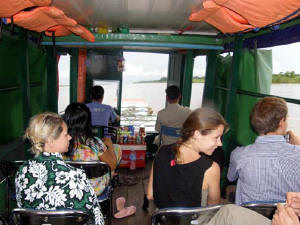
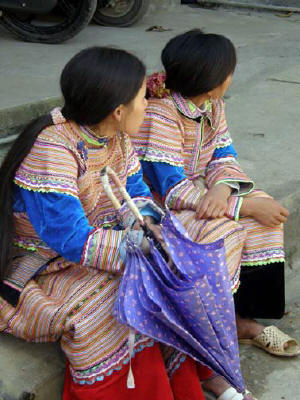
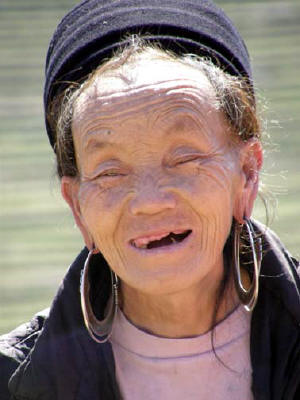
Entering Vietnam on the Mekong River
Flower Hmong Girls
Black Hmong Woman
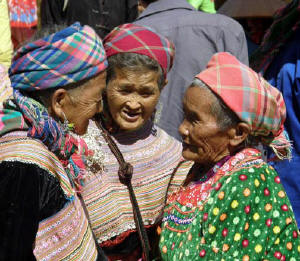
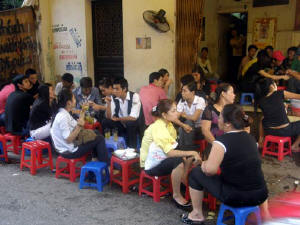
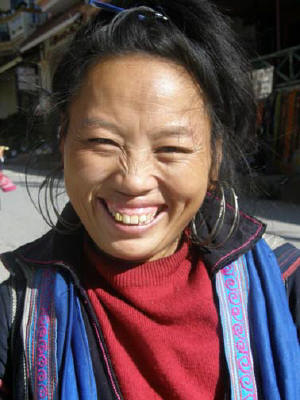
Flower Hmong Ladies
Typical Saigon Street Restaurant
Hmong Woman in Sapa
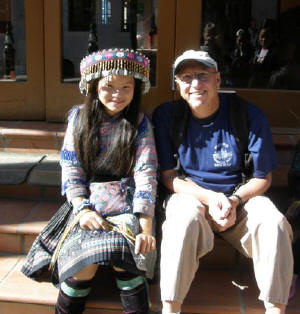
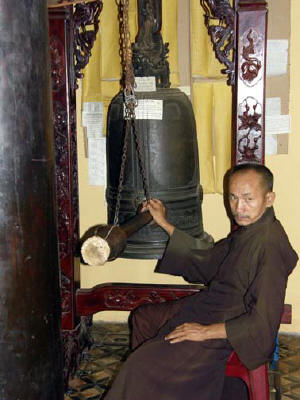
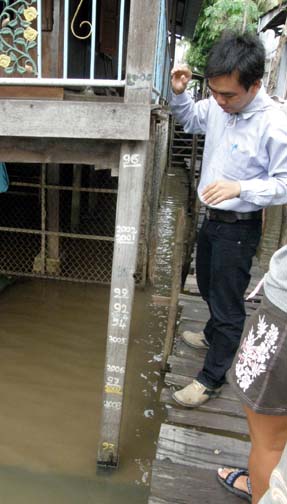
Rob with young Hmong Girl- she gave me
Monk banging a gong
River Gauge on Mekong
a bracelet- I think we may be married now.
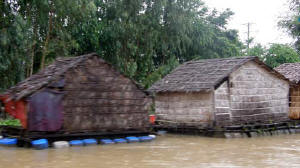
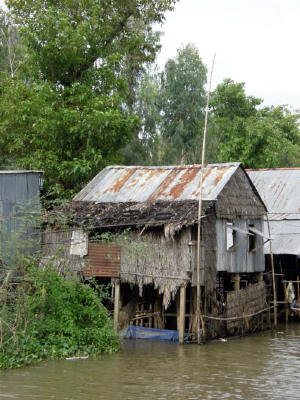
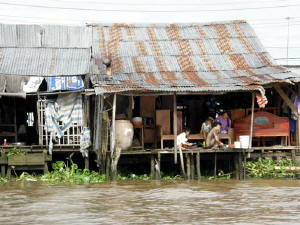
Typical houses along the Mekong River in the delta area
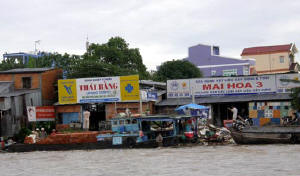
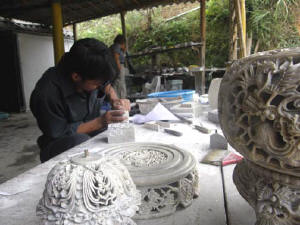
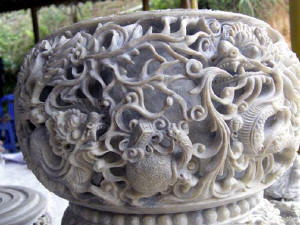
The river is the main thoroughfare
Carving Marble
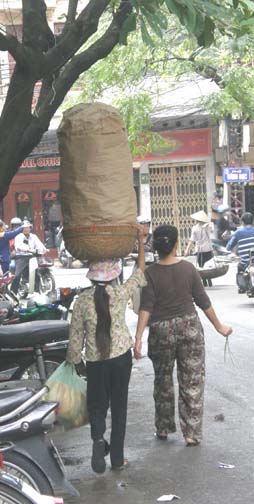
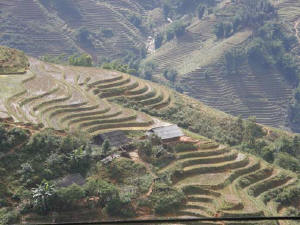
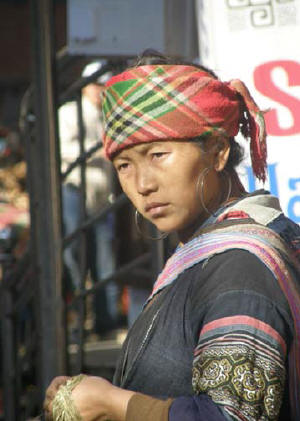
Carrying bread for sale
Terrace fields
Red Dao woman
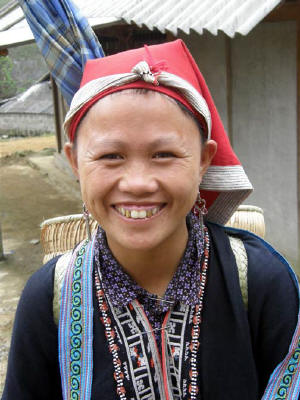
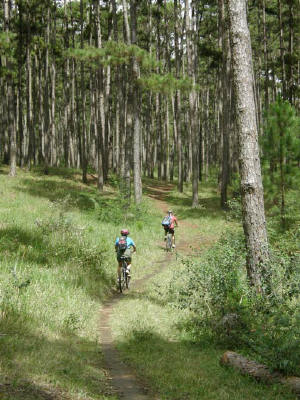
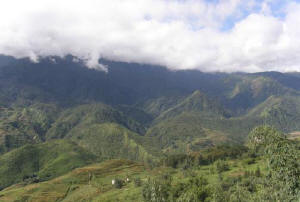
Red Dao woman
Mountain biking near Dalat
Northern Vietnam near Sapa
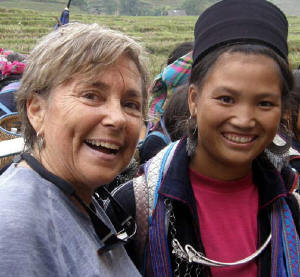
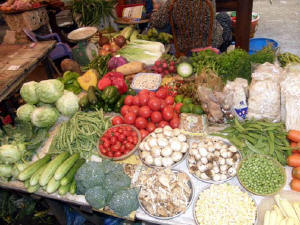
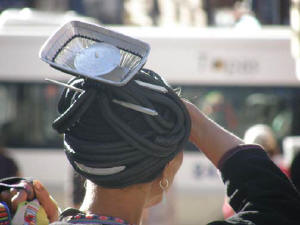
Dee and Black Hmong girl
Market produce
Black Dao headdress- looks like coiled snakes
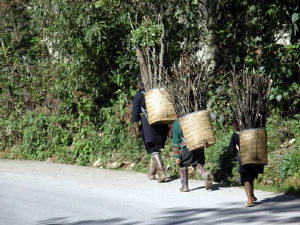
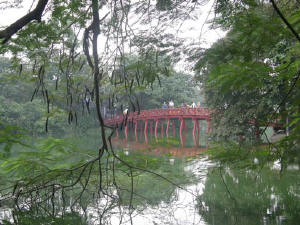
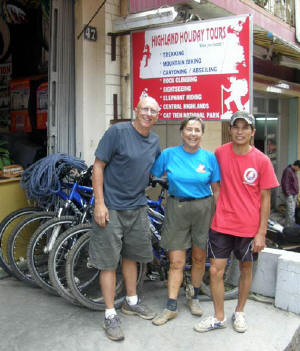
Whole family carrying firewood
Hanoi
Bike guide- with "the first really old people
he ever took mountain biking."
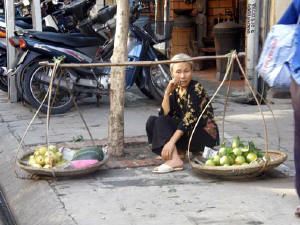
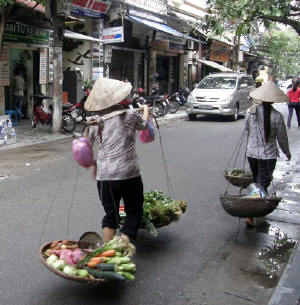
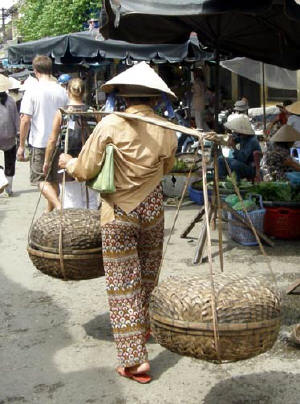
Everywhere you see women carrying loads up to 100 lbs. with these split bamboo
poles over their shoulders- They walk with a special very fast springing step
that makes the bamboo flex up and down so half the time the load is not on their
shoulder but sort of springing up in the air supported by the pole and making
their task easier.
There are two more pages of Vietnam photos - to see them
click the pages below
Vietnam Photos page 2
Vietnam Photos page 3

















